NiANSA Gathering: The iridescent whimsy of listening closely
Published July, 2025
by Nina Maštruko
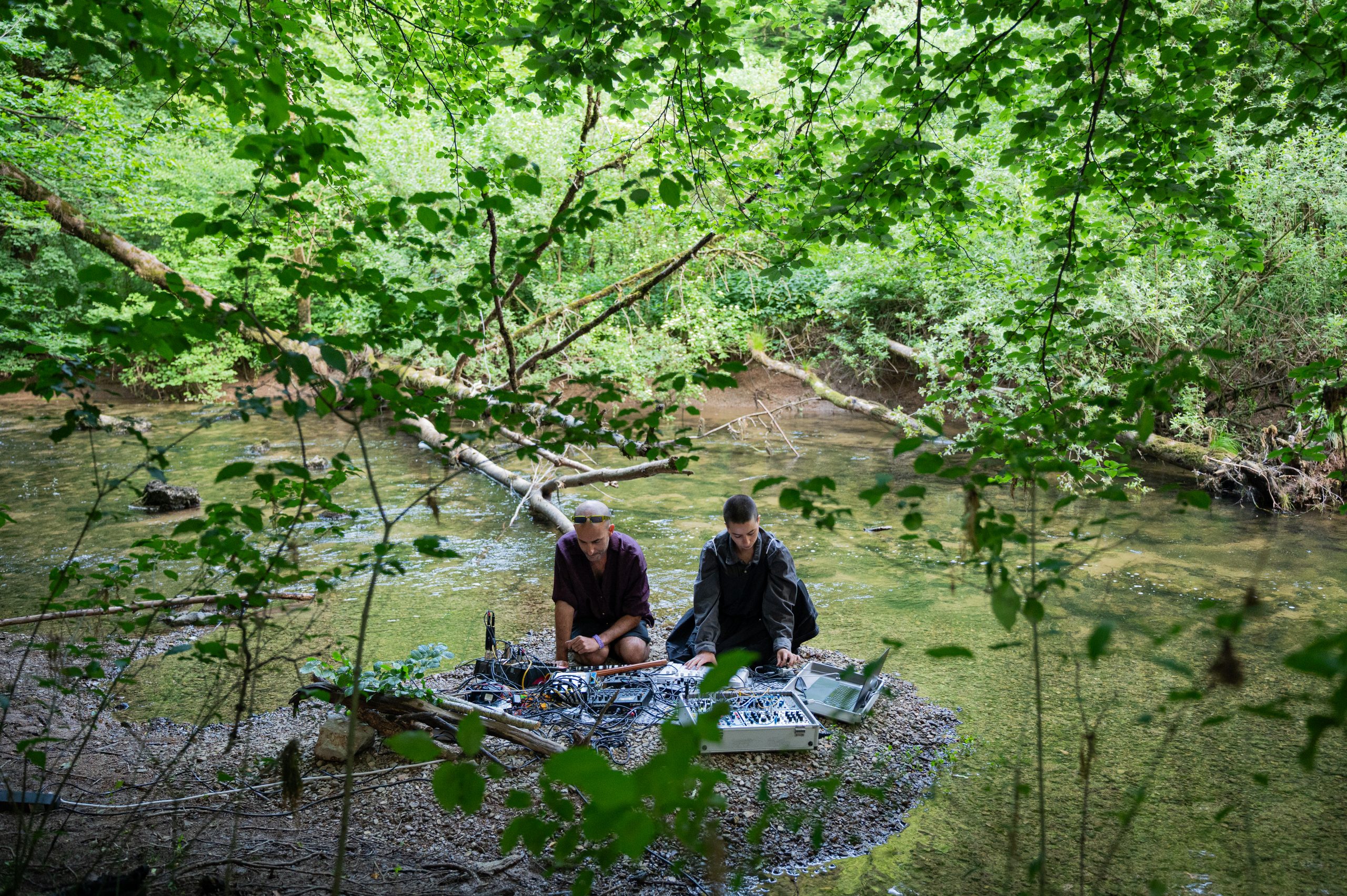
“It is important for humans to produce signals similar to those in nature – because we often forget that we are also from nature.” This sentiment, described by Boštjan Perovšek and Brane Zorman (BBtrem.) after their performance, echoes in my head.
Earlier that day, I happened to hitch a ride to the festival location with Juan López – a member of the organizational team of NiANSA, an atmospheric, exploratory sonic gathering in Slovenia. He is a Spanish biologist doing his PhD on animal communication in Ljubljana. Specifically, a PhD on the vibrational communication of insects – he explained, after I noticed illustrated booklets about insects and wild flowers on his dashboard. As one of the authors of the “Tremolo” performance with Boštian and Brane, he introduced the audience to the principles of biotremology, drawing a parallel between vibroscapes, collections of vibrations in an area and the soundscapes we were there to listen to. “At the moment, these meadows around you, they are just full of insects singing, just madness, chaos… “ exclaimed López. Using laser vibrometers, the trio measured insect vibrations on plants, documenting the vibroscape of the decaying construction site of Krater in Ljubljana. In the live performance, Boštjan and Brane placed the translated sounds of the “insect drummers” in a “pot” of atmospheric field recordings of Krater and interwove them with synths and other creaking and crackling sonic textures that intentionally sound as if they could be coming from a frazzled wasp or an unbothered praying mantis. The result was a humorously playful soundscape that created the sense of being deeply immersed in a bustling meadow, eavesdropping on insect conversations and mating calls. Drawing on existing principles of sonic ecologies and bioacoustic explorations, their concept went a step beyond electronic mimicry or collecting field recordings. Boštjan and Brane underlined that so-called artificial or man-made (electronic) sounds are natural too – and that the natural environment was in different ways reflected in all of the musical performances at the festival.
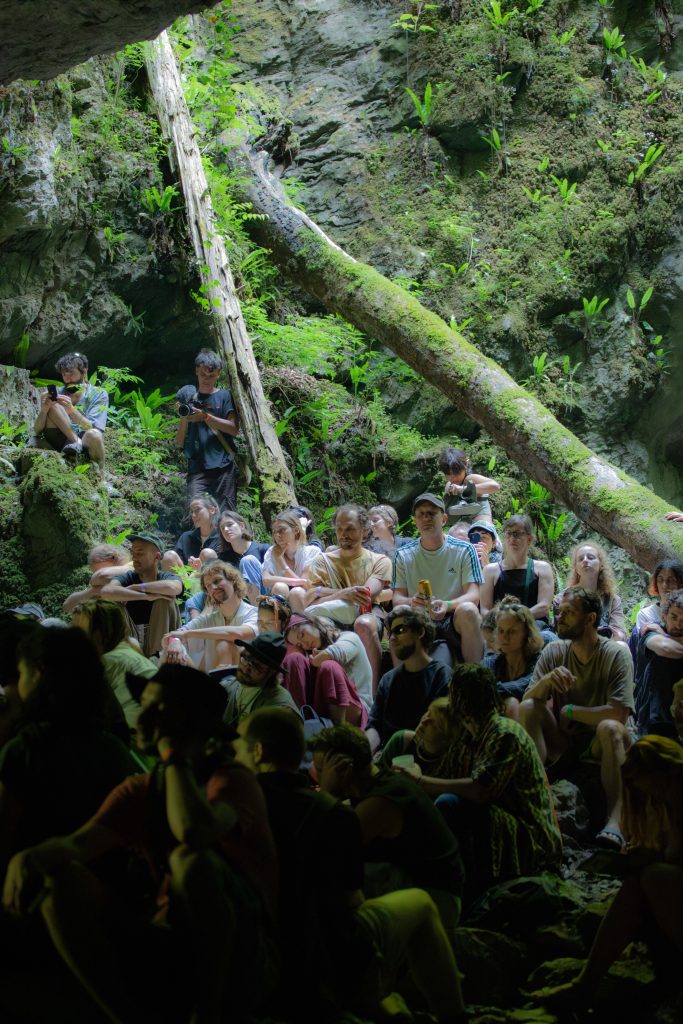
Line Gate by Valerija Intihar
And what an environment it is. A truly breathtaking forest landscape and karst terrain of Rakov Škocjan, Slovenia’s oldest landscape park, surrounds NiANSA. Nestled near the canyon of Rak river, this micro-festival lays a short walk away from massive karst wonders the river formed through the ages, creating 40 meter tall natural bridges and passage caves. Paying respect to this sublime environment, several site-specific performances and interventions took place around the area. The level of the interaction of the site-specific performances with the natural landscape varied. The modulating drone of Line Gate’s hurdy-gurdy and vocals echoed in a smaller cave-like passage, using the naturally formed auditorium as a visual and spatial focus. On the other hand, the mesmerising gravitas of Antez’ screeching noise frequencies – produced by dragging custom molded sculptures on a horizontal bass-drum – wasn’t exactly elevated by his chosen performance location, just outside the walls of the rustic Rakov Škocjan Hotel. A bit further down into the canyon, Argentinian electroacoustic musician and sound artist QOA and Argentinian electronic musician Primeiro, sat on the gravel of a tiny peninsula on the river bank, hunched over modular synths, a laptop and several controllers set up to process live input from a plethora of microphones.
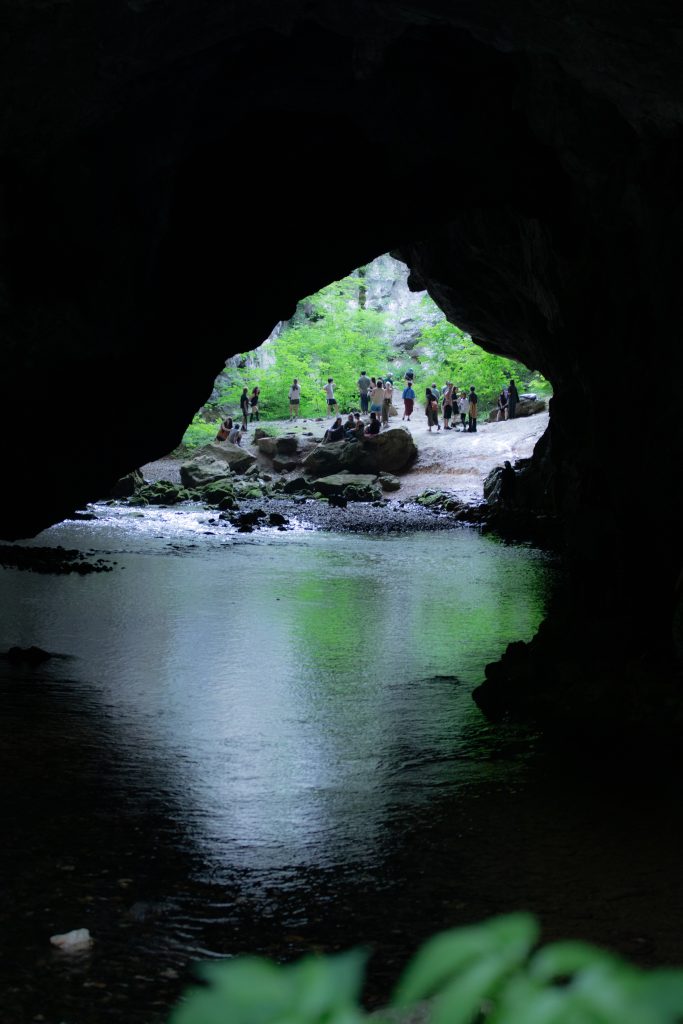
Photo Valerija Intihar
The interplay of their media expanded on the idea of harmonious mixing of biological and electronic sounds. QOA, drawing on their practice of collaging field recordings of natural environments, spoken word, live sampling, and drone, created an “extended listening experience” by amplifying the soft gargle of the babbling river, with one of the microphones softly placed on a slippery rock. Primeiro layered ambient atmospheres, ploinking synths and melodic arpeggios on top of the amplified drones and reverberations of organic matter. Listeners watched from between the trees, sat on damp river rocks with their feet in the water, or lay flat on tree trunks collapsed by the river. One of those trees became QOA’s instrument. By carefully placing geophones, a special type of contact microphones, they were able to play the wood not only as a percussion instrument using tapping or knocking, but also by plucking small branches like strings that resonated in different tones. The resulting performance was a meditative musing on the act of listening to the environment by giving it instrumental agency, and it felt most like a well-rounded site-specific musical experience.
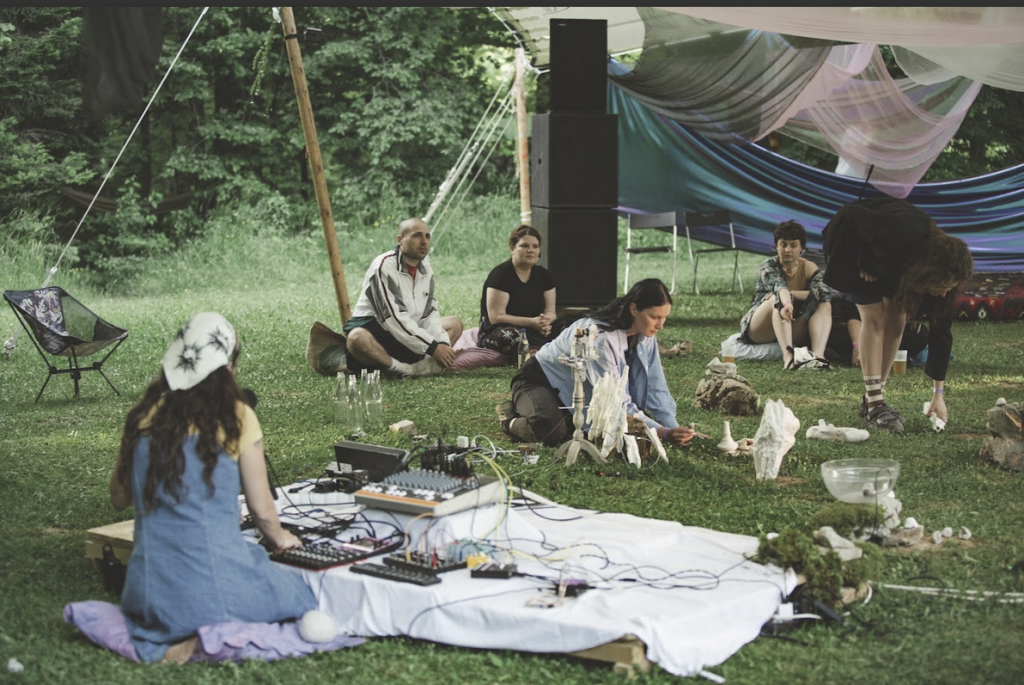
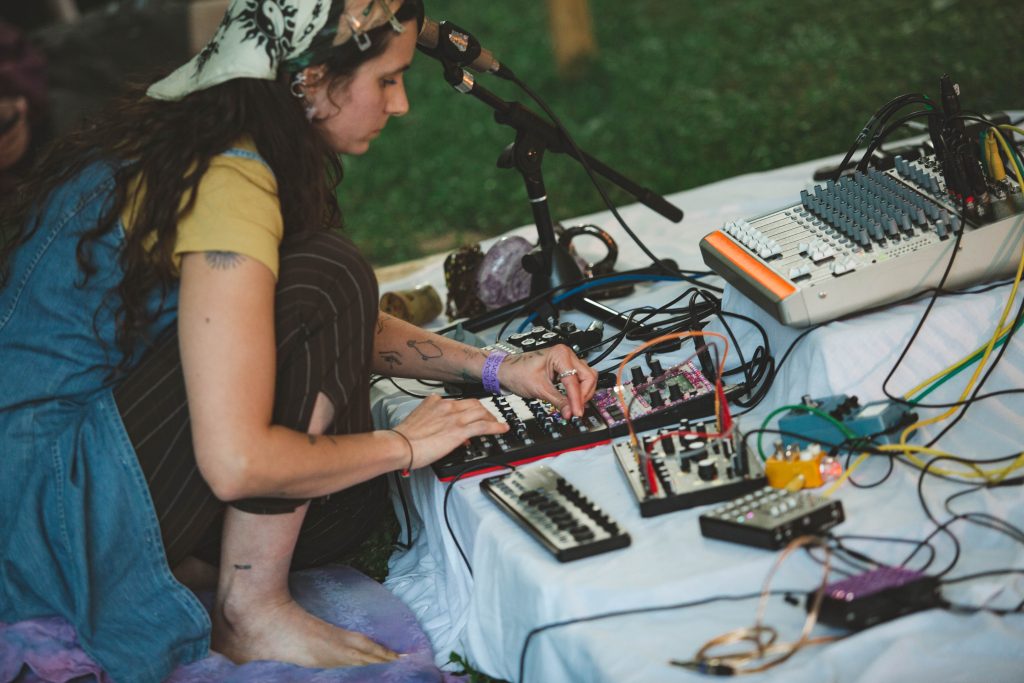
Lamina by Nina Pernat
Expanding on the festival’s dialogue with the natural setting, many other interventions and activities were similarly inspired by the surrounding ecosystem, including visual and light installations, workshops on foraging and gathering 3D karst models for VJing, pre-recorded and live sound walks, and more. Both curatorially and by the artists’ intuitive accord, many performances also relied on listening to nature and interacting with it through electronic human equivalents to nature’s playful randomness and non-linear logic. Bonnie Harris performed a participatory live piece using forest objects collected by participants of an earlier sound walk. Lamina, Ana Ščuka, and Maša Knapič collected and created sound objects on a 2-day SONICA x SHAPE+ residency at Rakov Škocjan, developing a sonic ecosystem at the intersection of sculpture, installation, and music. The performance almost felt tactile, with Maša and Ana shaping clay, dissolving it in water, and activating kinetic sculptures, while Lamina layered electronic ambients and melodies as a response to the biomechanical clattering and amplified fizzing captured by hydrophones. The residency brought them together for the first time, so they had to learn to listen to each other in a very short span of time. In that sense, the performance itself became a kind of deep listening exercise, only this time from the inside out: the performers tuning into one another to build something together, both sonically and physically.
NiANSA’s primary performance venue is a forest glade, with two eye-level stages placed facing each other. At first, the stages seemed mirrored, but it soon becomes apparent that each of them brings a distinct energy: one draped in flowing iridescent fabrics, with bits of the of the forest canopy visible through the gaps between them; the other hugged by heavier textiles of paragliding parachutes, with puffy textured surfaces for VJ and light experiments after dark. There is no overlap in the program, so positioning artists on different stages seems to primarily serve more seamless technical setups and changeovers, while also giving a little bit of space to curatorial play with the settings. NiANSA aims to “craft intentional spaces for collective listening and shared discovery,” and every word of the claim rings true. The collective listening experience is the headliner of this gathering, the artists – mediums for its manifestation. No matter how many listeners were in front of the stage during the performances, the artists were being closely listened to. No matter where I was in the venue, I was able to listen in different ways – whether I was moving my body, lying flat on my back, having quiet conversations at the table, keeping warm around the bonfire, eating delicious vegan stews and pancakes, or peeing in the bathroom. The sound is always following, but unlike at other festivals, it is always unintrusive. It doesn’t require a specific reaction or response; it is just there, like the scent of the trees.
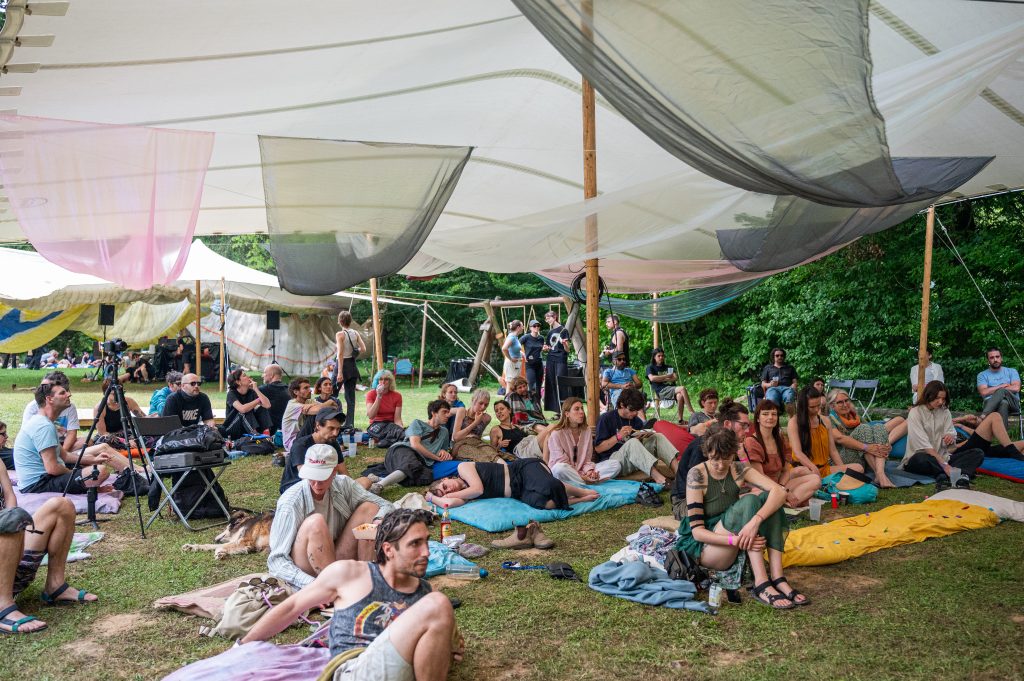
Photo Asiana Jurca Avci
Within the sonic bubbles of the two mirroring stages, the game of active listening came fully into the spotlight. People lay on handmade cushions, sat on chairs, logs, or simply the ground, which added an extra tactile dimension during more bass-heavy performances. Dancing was a situation that could happen at any given moment, be it in the middle of an ambient piece or when a switch to the next set suddenly introduced more concrete rhythmic patterns. The listening experience changed with my position in space. Step inside the bubble, and I was fully immersed in the high-quality sound design and its spatial features. By stepping outside, I could change the volume of the surrounding soundscapes: conversation, barking, or rustling leaves, which blend with the music. Not many artists took full advantage of the spatiality of the listening experience, with one of the exceptions being the Slovenian electroacoustic quartet Sujevera. During their ritualistic semi-structured improvisation, Nina Orlić walked through the crowd with a wooden rattle resembling a shellfish dreamcatcher, creating ASMR tingling on the back of my neck. Dialect’s hopefully melancholic science-fiction saga of “misunderstood, misappropriated bits of musical material” was accompanied by a costumed alien dancing and contorting while subtly moving between the listeners. Sometimes the tactile and visual expansions were not even planned, but merely a result of joyful synchronicities. As the Slovenian harpist rouge-ah conjured their dark drone ritual, the heavy textures mutating into noise with a screech, the wind surged, billowing through the iridescent fabrics around them, making it feel as though some form of sorcery was being unleashed. The clouds rushed across the sky, covering and uncovering the sun, the temperature constantly shifting, adding to nature’s own way of tactile VJ-ing.
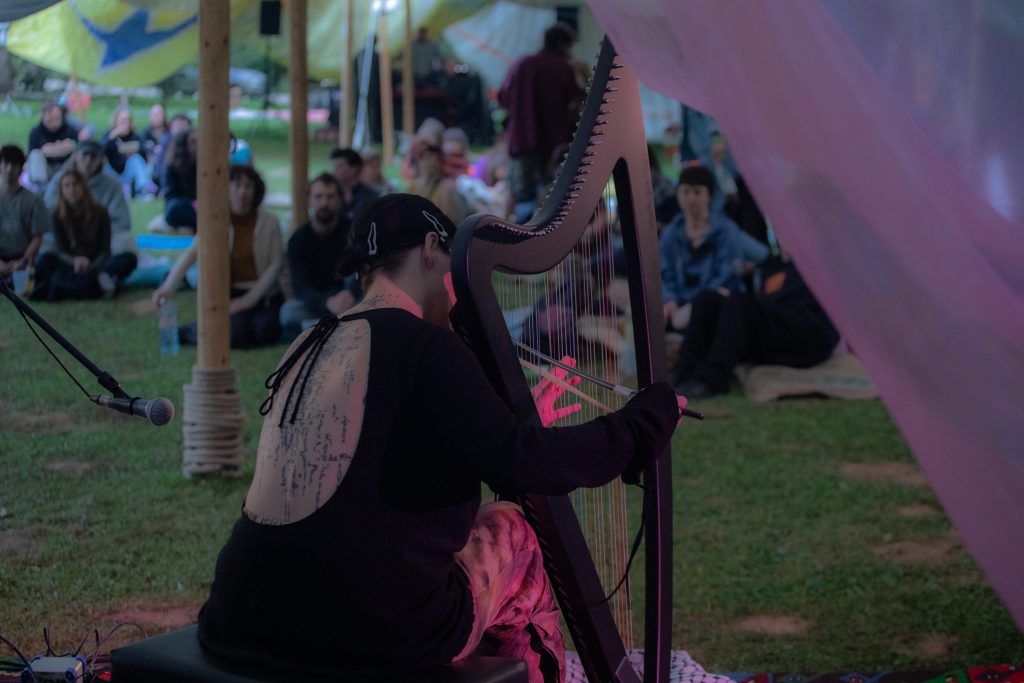
rouge-ah by Valerija Intihar
While I feared that a continuous programme of ambient music might prove to be cumbersome after a while, my doubts were laid to rest very quickly. These captivating performances are only some of the many impressive daylight sonic explorations that took place, each with its own characteristic taste. Numerous collaborations create the backbone of the festival programme. On top of including many of the most crucial faces and organizations of the Slovenian experimental and club scene, direct programme collaborations with SONICA, RX:TX, Level up, SSSS❍UNDED, SONOTOPIJA, CONA, ISOLABS, and Radio Študent nurtured exchanges with local like-minded organizations, along with the international programme connections with PAIKKA (Budapest), ARTETETRA (Italy) -ous (Zürich), and Mappa (Slovakia). This practice, aside from being crucial for the small festival’s financial sustainability, proved beneficial for the programme dynamics. I offer snippets of some of the scenes that still linger in my memory: the incredibly precise fingerwork and articulation of Joss Turnbull on the Iranian Tombak drum, showcasing the wide range of volume this traditional instrument can offer, running from pointillistic plucks to thunderous pulses, with the artist expanding on the base sounds with live sampling, glitches and reverberating effects. Joss carefully surveyed the surrounding audience, following their movements and, through improvisation, dialoging with the dancers, making them an extended part of the performance. Karmen Ponikvar created an imaginary orchestra of chirping crickets and croaking frogs. These elements that are more often associated with finding meditative peace and quiet, proved to be capable of soaring loudness, fully enveloping the listeners. Karmen’s set skillfully demonstrated an interplay between the spatiality of sound in the tactility of space. The Italian duo Babau blended humorously distorted vocal musings with optimistically-tinted electronic whizzing and whirring. The result was a quirky mish mash of 8bit energy and mantric minimalistic drum patterns that felt both timeless and unbound by any single cultural tradition. The Zürich-based label collective -ous’ showcase effortlessly glided from IOKOI’s whispering glitchy goodness and SLON’s emotional crescendos to Lua Jungck’s bass-driven triplet beats and INK!’s colder yet spacious techno DJ set.
DJ sets at the festival fit easily into the foraging mindset. Selectors needed to pick the sounds that might taste good on this meadow, as if they were popping cold blueberries to find out if they were sweet or sour. Some were placed in the daylight ambient setting, like DJ Final Form presenting his Modem Radio Študent show or the Palestinian filmmaker, DJ and radio selector Habkara suddenly breaking amorphous musical chirpings of the afternoon with rhythmic repetitions rooted in Middle Eastern musical styles. Rhythms were such a scarce resource within the ambient flows that when the time for them would finally arrive, the audience instantly responded by shifting their bodies and dancing – no warm up necessary. On Friday, the dancing started around 9pm, the more abstract drone and noise explorations of the afternoon by Kukorica and Palmovka suddenly contrasted by the curious selection and adventurous musical sampling of Julek ploski. He opened his set with a pompous march and continued to evolve further into dramatic orchestral swings, fast piano melodies decomposing into cumbia rhythms, sparkling arpeggios powering operatic hardstyle, constantly adding new layers of bitter sweetness. A musically impressive and honest set that easily became one of my favourites of the weekend. As he wrapped up his set, Julek tentatively broke the ceremonial gravity of the previous sets of the day by shortly speaking to the audience. It was a welcome moment of human intimacy that fit perfectly with the festival format and it made me wish more artists took the opportunity to do so. Later that evening, Loto Retina improvised an unforgettable DJ set after their luggage containing the live set equipment was lost at the airport. Proving to be the absolute champion of iridescent whimsy, their set blended insane layers of unexpected harmonies and polyrhythmic percussion seemingly emerging out of nowhere. Expanding further on the notion of artificial sound as natural, they engaged in an act of sonic worldbuilding with a truly fresh take on the possibilities of composition. This unique type of gnomish shenanigans fit right into the forest setting. The audience wasn’t interested in the linearity of usual dancefloor-oriented club music – this music was psychedelic to its core. There was never only one (re)solution to any sound loop or movement. Psychedelia was musically interpreted as absolute and constant change that feels instinctive and completely natural in its randomness. The trajectory of the set as a whole wasn’t necessarily going up or down – it was moving sideways in space at any given time, and so were the bodies of the captivated dancers. Following this chaotic deconstruction, Belgrade’s SAUD does the opposite – from the remaining dispersed spores of mushroom creatures he synthesized a singular focus: an ever-shifting yet forward-driving onslaught of basslines and percussion, offering a strong emotional expression interwoven with deconstructed notions of club masculinity. His set offered a resolution to Loto Retina’s dissolution and perfectly wrapped up the first night of dance.
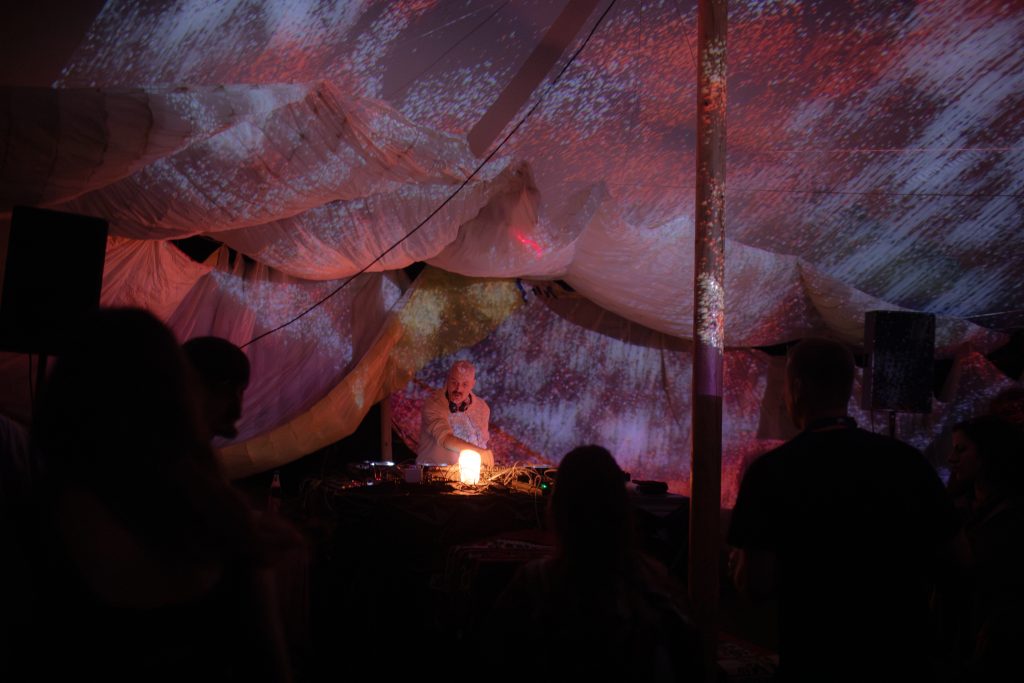
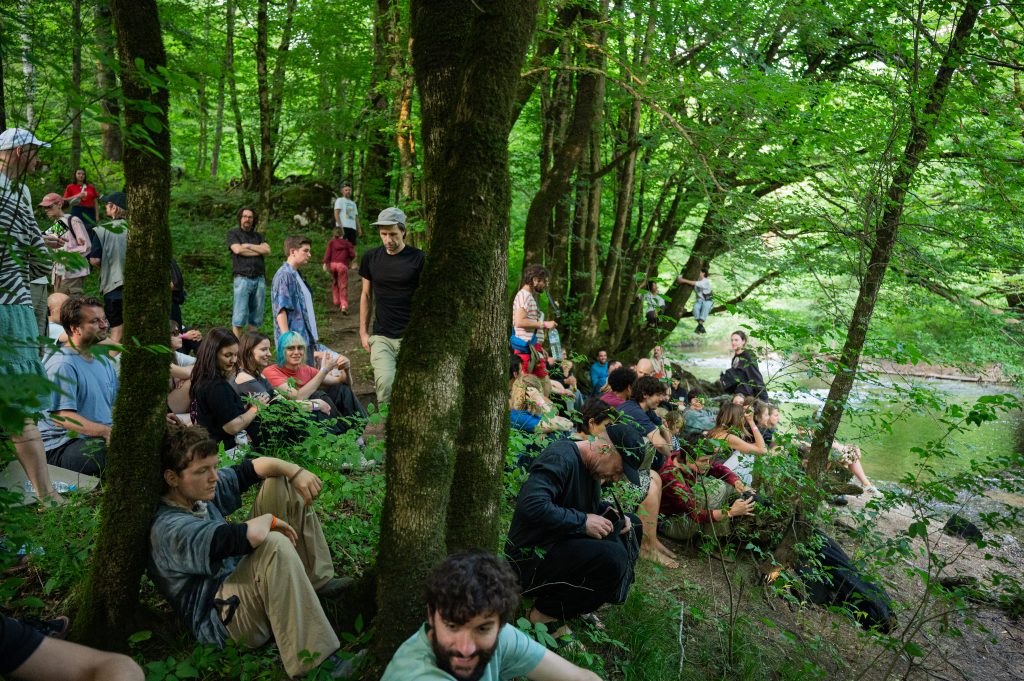
Photo top SAUD by Valerija Intihar, bottom Asiana Jurca Avci
There were so many great performances that it’s frustratingly hard to cover them all properly in one text (like Ulla, Roméo Poirier, Marka San, Señor Service, Raketa, Nice Trick, Muzikačaka, and many more who were all amazing in their own right!) – and that speaks to NiANSA’s nearly perfect curation. I say nearly perfect, because perfection would be boring anyway. This curatorial feat by Skopje-born, Ljubljana-based audio-visual artist, music curator, and event organizer Sašo Puckovski is even more impressive when you experience the way the performances unfold back to back. Even as an experienced curator, there is much you cannot predict with improvised or site-specific sets. However, this gap is bridged by the communal atmosphere seeping into every pore of the NiANSA experience – and perhaps just a little bit of luck. The idea of listening to natural-artificial sounds and creating meditative states around it might feel like it’s balancing on the brink of cliché, yet the program successfully bypasses all possible pitfalls of such an endeavor. Just like the performances themselves, the curation follows the fractal logic of growth, which, in tandem with the community around it, creates the collective sense of just existing in the moment. The risk of taking yourself too seriously in this mission is countered by the purely whimsical nature of the situations, interventions, and performances. The unspoken order within the joyful chaos at NiANSA demonstrated a set of shared values and experiences between the festival attendees. The sense of a code of conduct was spread somewhat instinctively, even if the laid-back attitude of the organization might have caused some of the logistical information to get lost in the noise. However, this can easily be solved by fostering even clearer and direct communication between the organizational team, the artists, and the attendees. What defines this community most is that the conversations after the performances never seemed to center around “What did you think?”, but “What did you feel?”.
Many answers can be true at once, depending on the viewer’s or listener’s perspective. Iridescence is the characteristic of containing multiple colours at once, and in the same way, there are always multiple possible listening outcomes and reactions at this gathering. An artificial electronic sound can be completely natural, a non-musical noise can be endlessly aesthetically exciting, and introspection can be a collective act. NiANSA reminded me once again that the iridescent whimsy of listening closely can be a genuine, albeit restful, act of resistance.
Text by Nina Maštruko
Lead photo QOA Primeiro by Asiana Jurca Avci
This article is brought to you as part of the EM GUIDE project – an initiative dedicated to empowering independent music magazines and strengthen the underground music scene in Europe. Read more about the project at emgui.de.
Funded by the European Union. Views and opinions expressed are however those of the author(s) only and do not necessarily reflect those of the European Union or the European Education and Culture Executive Agency (EACEA). Neither the European Union nor EACEA can be held responsible for them.